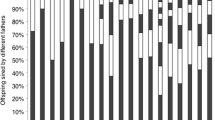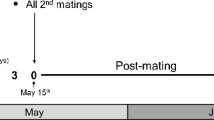Abstract
Intraspecific variation in the proportion of offspring sired by the second mate with a female (P2) is an aspect of sperm competition that has received little attention. I examined the effects of delay between copulations (range 9–380 days) and size of sperm donor on sperm precedence in double-mated individuals of the simultaneously hermaphroditic land snail Arianta arbustorum. Using shell colour as a genetic marker, paternity was analysed in 132 broods produced by 35 snails that had mated with two partners of different genotype. Sperm precedence (P2) was influenced by the time between the two matings when the mating delay exceeded 70 days (one reproductive season). P2 averaged 0.34 in the first brood of snails that mated twice within 70 days indicating first mate sperm precedence. In contrast, P2 averaged 0.76 in broods of snails that remated in the following season, indicating a decreased viability of sperm from the first mate. The size of sperm-donating individuals had no effect on the fertilization success of their sperm in the first brood produced after the second copulation. Analysis of long-term sperm utilization in 23 snails that laid three to nine egg batches over 2 years revealed striking differences among individuals. Five snails (21.7%) exhibited first-mate sperm precedence throughout, eight snails (34.8%) showed second-mate sperm precedence throughout, whereas ten snails (43.5%) exhibited sperm mixing in successive batches. It is suggested that the individual variation in sperm precedence in A. arbustorum may partly be due to differences in the amount of sperm transferred. Paternity analysis in 34 batches laid by 19 wild-caught individuals of A. arbustorum indicated that at least 12 snails (63.2%) used sperm from two or more mates for the fertilization of their eggs. This suggests a high incidence of multiple paternity in broods of A. arbustorum under field conditions.
Similar content being viewed by others
References
Baur B (1984) Shell size and growth rate differences for alpine populations of Arianta arbustorum (L.) (Pulmonata: Helicidae). Rev Suisse Zool 91:37–46
Baur B (1988a) Repeated mating and female fecundity in the simultaneously hermaphroditic land snail Arianta arbustorum. Invert Reprod Develop 14:197–204
Baur B (1988b) Population regulation in the land snail Arianta arbustorum: density effects on adult size, clutch size and incidence of egg cannibalism. Oecologia 77:390–394
Baur B (1990) Seasonal changes in clutch size, egg size and mode of oviposition in Arianta arbustorum (L.) (Gastropoda) from alpine populations. Zool Anz 225:253–264
Baur B (1992a) Random mating by size in the simultaneously hermaphroditic land snail Arianta arbustorum: experiments and an explanation. Anim Behav 43:511–518
Baur B (1992b) Cannibalism in gastropods. In: Elgar MA, Crespi BJ (eds) Cannibalism: ecology and evolution among diverse taxa. Oxford University Press, Oxford, pp 102–127
Baur B, Baur A (1986) Proximate factors influencing egg cannibalism in the land snail Arianta arbustorum (Pulmonata, Helicidae). Oecologia 70:283–287
Baur B, Baur A (1992) Effect of courtship and repeated copulation on egg production in the simultaneously hermaphroditic land snail Arianta arbustorum. Invert Reprod Develop 21:201–206
Baur B, Raboud C (1988) Life history of the land snail Arianta arbustorum along an altitudinal gradient. J Anim Ecol 57:71–87
Bernasconi G (1993) Outnumbering the rivals' sperm: intraspecific variation in sperm expenditure in a hermaphroditic land snail. Master thesis, University of Basel
Birkhead TR, Hunter FM (1990) Mechanisms of sperm competition. Trends Ecol Evol 5:48–52
Birkhead TR, Møller AP (1992) Sperm competition in birds. Evolutionary causes and consequences. Academic Press, London
Boorman E, Parker GA (1976) Sperm (ejaculate) competition in Drosophila melanogaster, and the reproductive value of females to males in relation to females age and mating status. Ecol Entomol 1:145–155
Chen X (1993) On reproductive strategies in hermaphroditic land snails. PhD thesis, University of Basel
Chen X, Baur B (1993) The effect of multiple mating on female reproductive success in the simultaneously hermaphroditic land snail Arianta arbustorum. Can J Zool 71:2431–2436
Cook LM, King JMB (1966) Some data on the genetics of shell-character polymorphism in the snail Arianta arbustorum. Genetics 53:415–425
Duncan CJ (1975) Reproduction. In: Fretter V, Peake J (eds) Pulmonates, vol. 1. Academic Press, London, pp 309–365
Gaffney PM, McGee B (1992) Multiple paternity in Crepidula fornicata (Linnaeus). Veliger 35:12–15
Ginsberg JR, Huck UW (1989) Sperm competition in mammals. Trends Ecol Evol 4:74–79
Griffond B, Gomot L (1989) Endocrinology of reproduction in stylommatophoran pulmonate gastropods with special reference to Helix. Comp Endocrinol 8:23–32
Gwynne DT (1984) Male mating effort, confidence of paternity, and insect sperm competition. In: Smith RL (ed) Sperm competition and the evolution of animal mating systems. Academic Press, New York, pp 117–149
Hofmann E (1923) Uber den Begattungsvorgang von Arianta arbustorum L. Jen Zeitsch Naturw 59 (NF 52):363–400
Johnson C (1977) The use of gene frequencies in estimating the mean number of mates in a multiple-mate and stored-sperm system of mating. Theor Appl Genet 49:181–185
Kerney MP, Cameron RAD (1979) A field guide to the land snails of Britain and North-West Europe. Collins, London
Lang A (1904) Uber Vorversuche zu Untersuchungen Uber die Varietätenbildung von Helix hortensis Müller und Helix nemoralis L. Denkschr Med Naturw Ges Jena 11:437–506
Lessells CM, Birkhead TR (1990) Mechanisms of sperm competition in birds: mathematical models. Behav Ecol Sociobiol 27:325–337
Lewis SM, Austad SN (1990) Sources of intraspecific variation in sperm precedence in red flour beetles. Am Nat 135:351–359
Lind H (1973) The functional significance of the spermatophore and the fate of spermatozoa in the genital tract of Helix pomatia (Gastropoda: Stylommatophora). J Zool Lend 169:39–64
Mulvey M, Vrijenhoek RC (1981) Multiple paternity in the hermaphroditic snail, Biomphalaria obstructs. J Hered 72:308–312
Murray J (1964) Multiple mating and effective population size in Cepaea nemoralis. Evolution 18:283–291
Oldham C (1934) Some albinistic varieties of Arianta arbustorum (L.). Proc Malacol Soc Lend 21:103–108
Owiny AM (1974) Some aspects of the breeding biology of the equatorial land snail Limicolaria rnartensiana (Achatinidae: Pulmonata). J Zool Lond 172:191–206
Parker GA (1970) Sperm competition and its evolutionary consequences in the insects. Biol Rev 45:525–568
Parker GA (1984) Sperm competition and the evolution of animal mating strategies. In: Smith RL (ed) Sperm competition and the evolution of animal mating systems. Academic Press, New York, pp 1–60
Parker GA (1990a) Sperm competition games: raffles and roles. Proc R Soc Lond B 242:120–126
Parker GA (1990b) Sperm competition games: sneaks and extra-pair copulations. Proc R Soc Lond B 242:127–133
Parker GA (1992) Marginal value theorem with exploitation time costs: diet, sperm reserves, and optimal copulation duration in dung flies. Am Nat 139:1237–1256
Parker GA (1993) Sperm competition games: sperm size and sperm number. Proc R Soc Lond B 253:245–254
Parker GA, Simmons LW (1991) A model of constant random sperm displacement during mating: evidence from Scatophaga. Proc R Soc Lond B 246:107–115
Parker GA, Simmons LW, Kirk H (1990) Analysing sperm competition data: simple models for predicting mechanisms. Behav Ecol Sociobiol 27:55–65
Raut SK, Ghose KC (1979) Viability of sperm in two land snails, Achatina fulica Bodwich and Macrochlamys indica Godwin-Austen. Veliger 21:486–487
Rant SK, Ghose KC (1982) Viability of sperms in aestivating Achatina fulica Bodwich and Macrochlamys indica Godwin-Austen. J Mollusc Stud 48:84–86
Rollinson D, Kane RA, Linnes JRL (1989) An analysis of fertilization in Bulinus cernicus (Gastropoda: Planorbidae). J Zool Lond 217:295–310
Saleuddin ASM, Griffond B, Ashton ML (1991) An ultrastructural study of the activation of the endocrine dorsal bodies in the snail Helix aspersa by mating. Can J Zool 69:1203–1215
SAS Institute (1991) SAS user's guide: statistics (1991 edn). SAS Institute, Cary
Simmons LW, Parker GA (1992) Individual variation in sperm competition success of yellow dung flies, Scatophaga stercoraria. Evolution 46:366–375
Siva-Jothy MT, Tsubaki Y (1989) Variation in copulation duration in Mnais pruinosa pruinosa Selys (Odonata: Calopterygidae). 1. Alternative mate-securing tactics and sperm precedence. Behav Ecol Sociobiol 24:39–45
Smith RL (ed) (1984) Sperm competition and the evolution of animal mating systems. Academic Press, New York
Tompa AS (1984) Land snails (Stylommatophora). In: Tompa AS, Verdonk NH, Biggelaar JAM van den (eds) The Mollusca, vol. 7. Academic Press, London, pp 47–140
Walker WF (1980) Sperm utilization strategies in nonsocial insects. Am Nat 115:780–799
Wethington AR, Dillon RT (1991) Sperm storage and evidence for multiple insemination in a natural population of the freshwater snail, Physa. Am Malacol Bull 9:99–102
Author information
Authors and Affiliations
Additional information
Communicated by M.A. Elgar
Rights and permissions
About this article
Cite this article
Baurl, B. Multiple paternity and individual variation in sperm precedence in the simultaneously hermaphroditic land snail Arianta arbustorum . Behav Ecol Sociobiol 35, 413–421 (1994). https://doi.org/10.1007/BF00165844
Received:
Accepted:
Issue Date:
DOI: https://doi.org/10.1007/BF00165844




